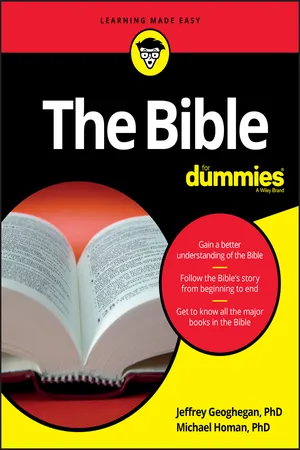
- English
- ePUB (mobile friendly)
- Available on iOS & Android
The Bible For Dummies
About this book
The Bible For Dummies (9781119293507) was previously published as The Bible For Dummies (9780764552960). While this version features a new Dummies cover and design, the content is the same as the prior release and should not be considered a new or updated product.
Discover the world's all-time bestseller in an entirely new light Ninety percent of Americans own a copy of the Bible, and while it's the most widely read book, it's also the least understood. Regardless of your religion, understanding the Bible brings much of Western art, literature, and public discourse into greater focus—from Leonardo da Vinci's "Last Supper" painting to the Wachowski brothers' The Matrix movies. People have historically turned to religion to deal with tragedy and change, and with the right insight, the Bible can be an accessible, helpful guide to life's big questions.
The Bible For Dummies appeals to people of all faiths, as well as those who don't practice any particular religion, by providing interfaith coverage of the entire Bible and the often fascinating background information that makes the Bible come alive. You'll find answers to such questions as:
- Where did the Bible come from?
- Who wrote the Bible?
- How is the Bible put together?
Follow the history of the Bible from its beginning thousands of years ago as tattered scrolls to its status as the bestseller of all time. The Bible For Dummies covers these topics and more:
- Ten people in the Bible you should know
- The Hebrew Bible
- The Apocrypha's hidden treasures
- What's new about the New Testament
- Israel's wisdom, literature, and love poetry
- The Bible's enduring influence
- The prophets: more than fortunetellers
Whether you're interested in broadening your spiritual horizons, uncovering the symbolism of Western culture, or gaining a deeper understanding of the book you grew up reading, The Bible For Dummies has all the information you need to navigate this ancient and fascinating book.
Frequently asked questions
- Essential is ideal for learners and professionals who enjoy exploring a wide range of subjects. Access the Essential Library with 800,000+ trusted titles and best-sellers across business, personal growth, and the humanities. Includes unlimited reading time and Standard Read Aloud voice.
- Complete: Perfect for advanced learners and researchers needing full, unrestricted access. Unlock 1.4M+ books across hundreds of subjects, including academic and specialized titles. The Complete Plan also includes advanced features like Premium Read Aloud and Research Assistant.
Please note we cannot support devices running on iOS 13 and Android 7 or earlier. Learn more about using the app.
Information
What the Bible Is All About
From Moses to Modernity: Introducing the Good Book
Tracing the Bible from Old Scrolls to the Bestseller of All Time
What is the Bible?
Where did the Bible come from?
The Hebrew Bible (or Old Testament)
Table of contents
- Cover
- Title Page
- Table of Contents
- Introduction
- Part 1: What the Bible Is All About
- Part 2: Exploring the Hebrew Bible — The Old Testament
- Part 3: Revealing the Bible’s Hidden Treasures in the Apocrypha
- Part 4: Discovering What’s New About the New Testament
- Part 5: That Was Then, This Is Now: Discovering the Bible’s Enduring Influence
- Part 6: The Part of Tens
- About the Authors
- Advertisement Page
- Connect with Dummies
- End User License Agreement
